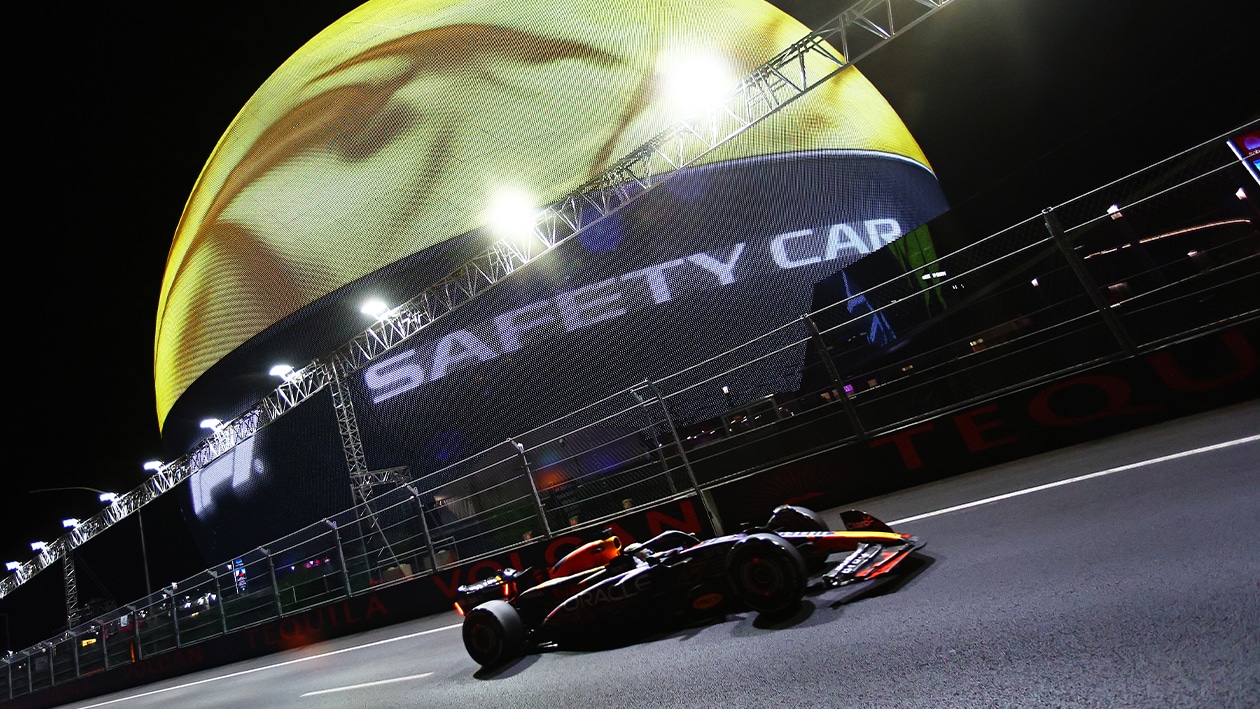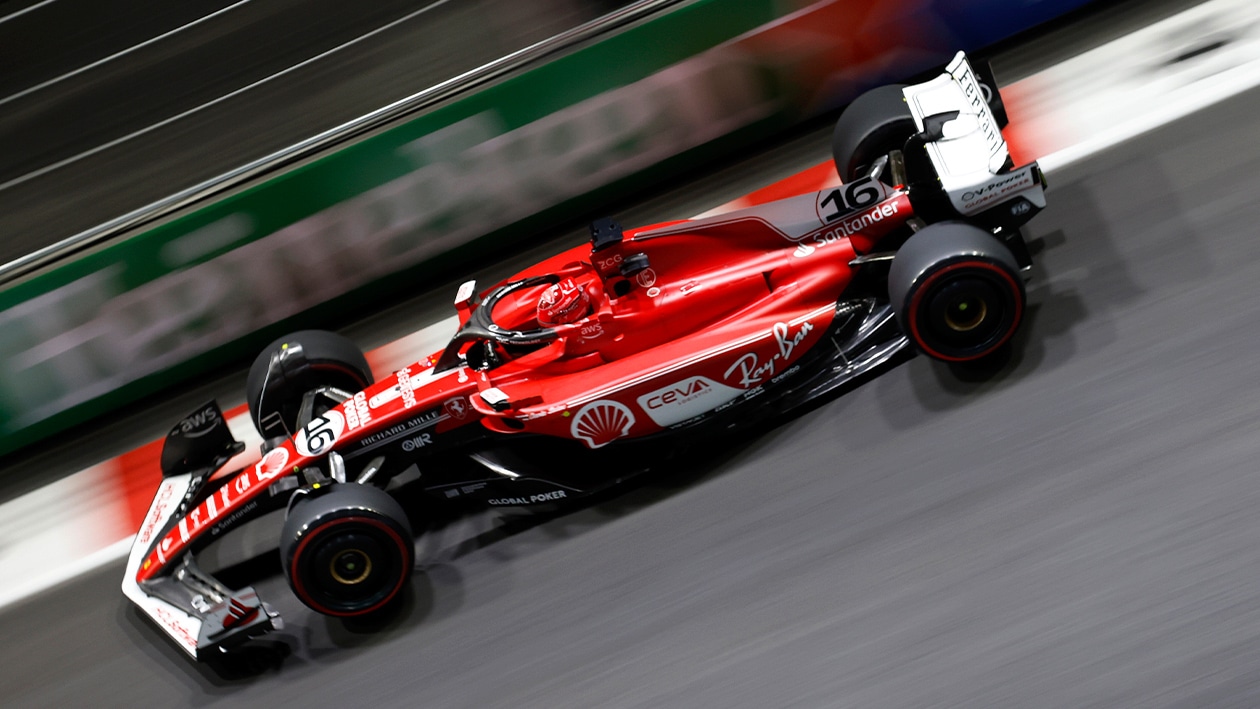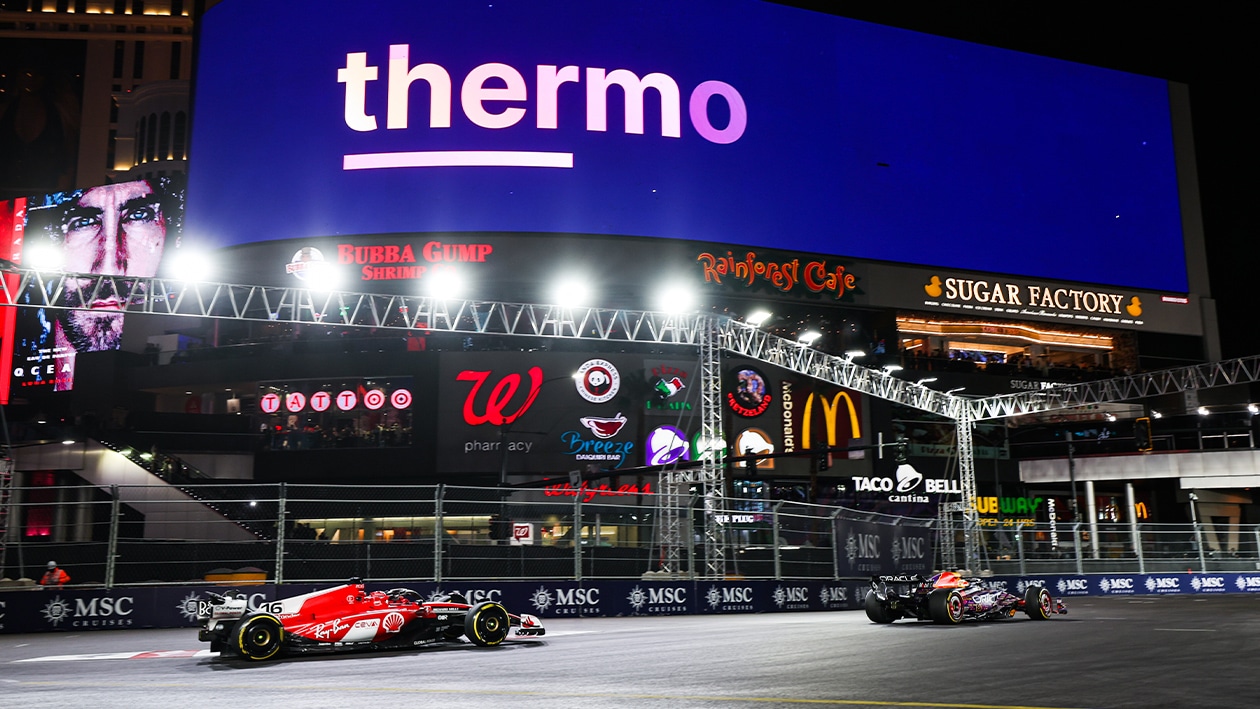The picture that shows why Verstappen won the Las Vegas GP
Charles Leclerc would have won the the 2023 Las Vegas Grand Prix had it not been for Max Verstappen and George Russell's clash, writes Mark Hughes. Far from hampering the Red Bull, the damage clinched F1 victory

Broken front wing of Verstappen's Red Bull is visible during safety car period caused by the debris
Mark Thompson/Getty Images
Contrary to the cynical expectations of many, the new Las Vegas Grand Prix gave us a truly spectacular race: five overtake lead changes and a thrilling contest through the field. It was won by Max Verstappen, but almost certainly wouldn’t have been were it not for an opportunely-timed safety car. We got a great race as drivers and teams staged various recoveries from randomly-timed interruptions. For some the recoveries were from blows imposed by the safety car, for others their recoveries were only possible because of it.
It wasn’t entirely random of course. There was merit in how Verstappen grasped his second chance at defeating Charles Leclerc’s Ferrari with fierce desire and relentless pace made possible by how low the degradation rate of the hard tyre was on the low-grip surface. But up until the second safety car – ironically triggered by Verstappen being driven into by George Russell (“Totally my fault,” admitted Russell, “I didn’t think he’d be there,”) – this was going to be Leclerc’s race.
After being pushed out wide by Verstappen at the first turn of the race, Leclerc had pressured him into over-working his medium compound tyres, forcing the Red Bull into the pits far too early. Furthermore, he had to wait there for a 5sec penalty to be served for the first corner incident. Which meant he was well down upon rejoining. When Leclerc rejoined after his first stop he was four places ahead and on much newer tyres. One of the cars between them was Carlos Sainz’s Ferrari – so all-in-all it was difficult to see how Leclerc could have lost from there. The Ferrari’s tyres were holding up fine on a track so cool, the low-down response of its smaller turbo/long inlet engine was punching it out of the slow corners beautifully. Ferrari was in great shape here. The track could hardly have been conceived better for its traits – and Leclerc was going with it, always particularly mighty when there are walls to thread the car between. Red Bull had given up on trying to compete with him for pole and fitted Verstappen with a lower wing which was slower over the lap but gave him a chance to race, a choice helped by their knowledge that Sainz would be taking a 10-place grid penalty for replacing the battery destroyed by the manhole cover on Friday. Sainz duly qualified second-fastest but his penalty put Verstappen on the front row.

Ferrari was the first F1 team to announce its 2024 reveal date
Chris Graythen/Getty Images

Verstappen runs wide at the start – and takes Leclerc with him
Chris Graythen/Getty Images

Pressure from Leclerc hurt Verstappen’s tyres
Antonin Vincent / DPPI
All these random factors intermingle to make the end result. From the front row to Verstappen pushing Leclerc wide, the 5sec penalty, the lap 1 VSC, the lap 3 safety car which meant two aggressive starts from cold tyres on heavy fuel for Verstappen as he was determined to pull out of Leclerc’s slipstreaming range. The way that determined when he stopped and how many places he lost. How that compounded to him being behind Russell and triggering the second safety car – which came to his rescue, exchanging a bit of front wing endplate damage for fresher tyres than Leclerc. The VSC was for some Fernando Alonso-induced carnage at Turn 1, as he spun the Aston mid-pack, cold tyres on the slippery surface and caused carnage. The VSC in turn meant Lando Norris’s McLaren grounded out on low tyre pressures and heavy fuel shortly after the restart – triggering the first safety car after a massive accident from which he emerged unscathed.
The second safety car came just five laps after Leclerc’s stop, when he was lying third. Staying out vaulted him into the lead. Had he pitted, he’d have been behind Sergio Perez’s Red Bull. Instead, he was leading it. But vulnerable. “Five laps difference on the hards is not too much,” he said, “but the problem was trying to restart a used tyre after a safety car is incredibly difficult at those temperatures. There we lost the race.”

Perez vs Leclerc on the Strip
Kym Illman/Getty Images
But in a fighting way. Perez stalked him but with his bigger wing couldn’t initially make a pass. He finally figured out a way after six laps, making Leclerc use up his battery, leaving him defenceless in the DRS zone at the end of the super-long back straight. Meanwhile Verstappen was able to quickly clear the cars of Pierre Gasly and Oscar Piastri which had been between him and Perez. What Perez really needed now was for Leclerc to keep Verstappen off his back. So, like Sainz in Singapore, he allowed his pursuer to get within DRS reach, hoping to tow Leclerc along fast enough to thwart Verstappen. So long as the gap was more than 0.5sec at the DRS detection point, he reckoned he was safe from Leclerc being able to pass. His race engineer would inform him of the gap each lap. On lap 35 the gap had been 0.7sec so he wasn’t even really defending into Turn 14 when Leclerc suddenly turned up alongside! It was a demon move – and got him the lead back. It also made Perez vulnerable to Verstappen who on the next lap passed easily with the combined benefit of DRS and his smaller wing. Two laps after that and he DRS’d his way by Leclerc too and from there was home and dry. Leclerc briefly gave Perez second back after locking a wheel into Turn 14, but got him back into the same turn with another late-braking move on the final lap.
There were many great drives – some rewarded, others not. The difference was just one of luck. Which is always a precious commodity at Vegas.
